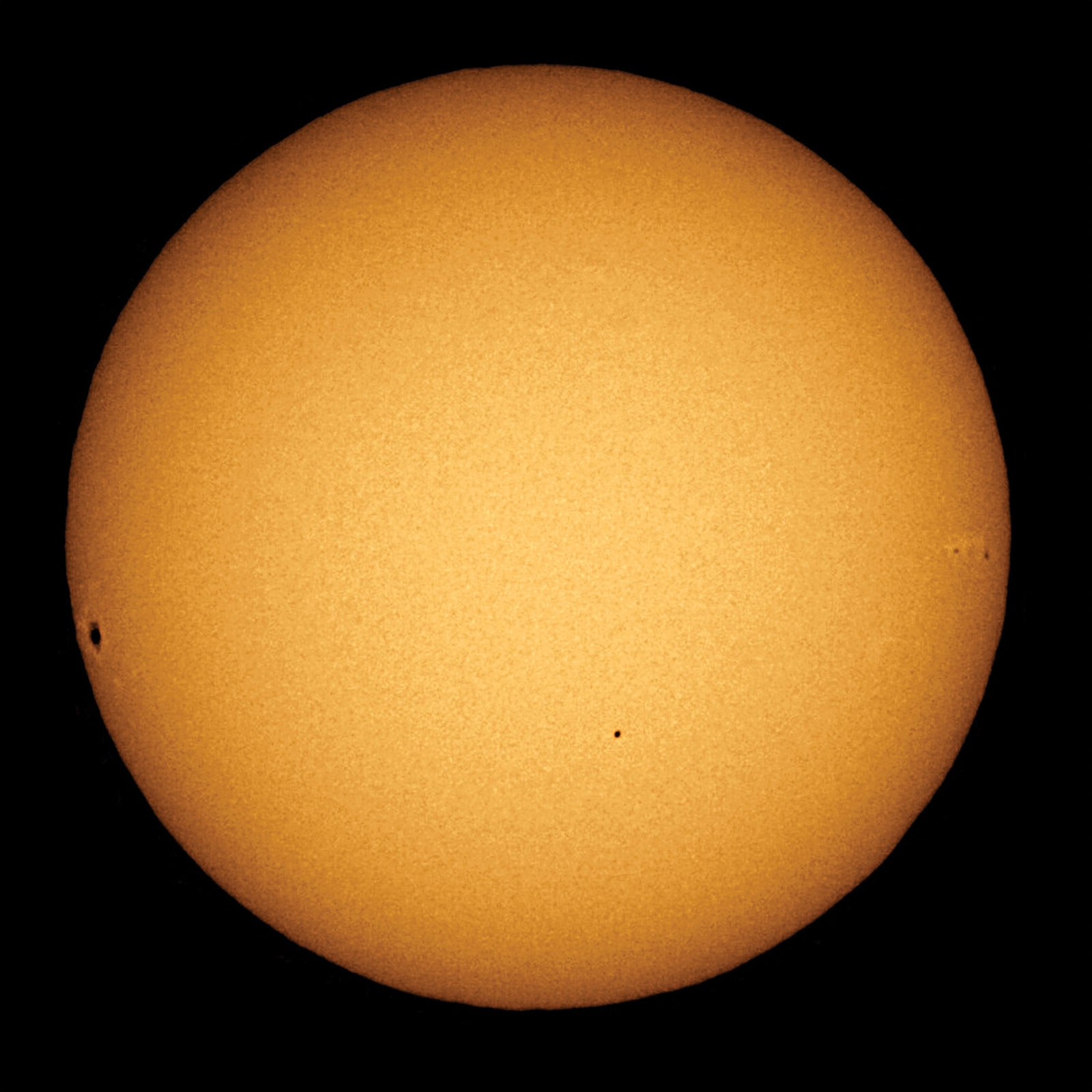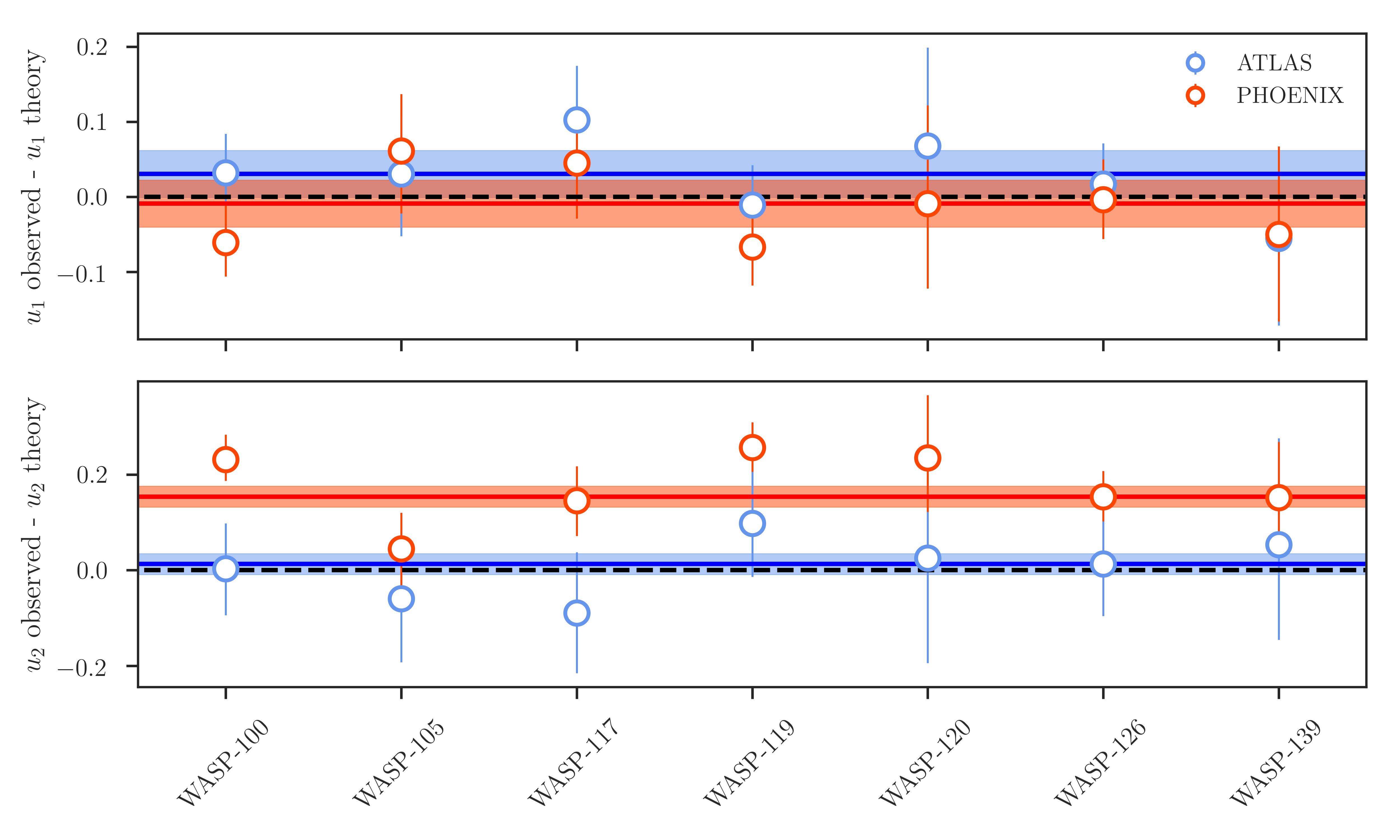Jayshil A Patel
Study of the limb darkening effect and transit parameters of known exoplanets with TESS
Category: Non-fiction, TESS, My research; Date: June 14, 2020
The principal objective of my first formal research project, which was also the project of my Master's thesis which I did under the guidance of Dr Néstor Espinoza at the Max-Planck Institute for Astronomy in Heidelberg, Germany (now at the Space Telescope Science Institute - STScI, USA), was to study the limb darkening effect using the exoplanet transit light curves entitled "Study of the limb darkening effect using exoplanet transit light curves using TESS data".
 Figure 1: Solar limb darkening effect
Figure 1: Solar limb darkening effect
(Credits: Encyclopædia Britannica)While looking
at the solar disk it can be easily seen that the solar brightness is not constant over the disk.
Instead, as we move towards the limb it gets darker; this effect termed as the limb darkening effect of the sun (see Figure 1).
Although for stars other than the Sun the limb darkening effect cannot be observed directly, it is there,
because the reason behind the limb darkening effect lies in the decreasing temperature of the stellar atmosphere with height,
which is not the specific for the Sun but a general phenomenon.
The effect arises because when we look at the stellar limb we are looking at the higher parts of the atmosphere,
which are cooler and so radiates fewer amounts of energy and thus appears darker than the centre.
This effect can affect the exoplanet transit light curve.
If there were no limb darkening effect, the transit light curve would have a flat bottom,
as the exoplanet would block the same amount of light while moving in front of the stellar disk.
But, due to the limb darkening effect, the exoplanet would hinder the different amount of light and
that will result into 'U' shaped bottom of exoplanet transit light curve (see Figure 2).
We used exoplanet transit light curve data from recently launched satellite TESS in this work.
 Figure 2: Effect of limb darkening on the transit light-curve. Planetary parameters are of the planet WASP-5b calculated using juliet (Espinoza et al. 2018). We used, in this case, quadratic law to quantify the effect of limb darkening. Model transit light-curve calculated using batman (Kreidberg 2015)
Figure 2: Effect of limb darkening on the transit light-curve. Planetary parameters are of the planet WASP-5b calculated using juliet (Espinoza et al. 2018). We used, in this case, quadratic law to quantify the effect of limb darkening. Model transit light-curve calculated using batman (Kreidberg 2015)The Transiting Exoplanet Survey Satellite or TESS, as its name suggests, is a NASA mission led by the Massachusetts Institute of Technology (MIT) to survey roughly whole sky with the primary goal of detecting new transiting exoplanets. Its main target stars are bright nearby (within about 200 pc) stars with spectral types ranging from F5 to M5. The most notable feature of these target stars is their vicinity from the earth. This proximity ensures that each TESS target could have (or some of them already have) follow-up observations from ground-based facilities. We needed these follow-up observations of host stars of our intended target exoplanets to get the refined measurements of stellar properties and to make sure that the intended target is not a false positive but a real exoplanet. That is why we chose previously known exoplanets which already have follow-up observations. This makes our sample size as large as to include 170+ exoplanetary systems that consists of all known transiting exoplanets observed by TESS during its observation sectors 1 to 32.
We used this transit light-curve data from TESS of already known 170+ exoplanetary systems, which have follow-up observations, and modelled it using appropriate software. This modelling yield various planetary as well as stellar parameters including the limb darkening coefficients (LDCs). We used these results to test how well the limb darkening effect is modelled by stellar model atmospheres like ATLAS and PHOENIX. To do that we compared the retrieved LDCs with both ATLAS and PHOENIX model predictions calculated by two authors Claret (2017) and Espinoza & Jordán (2015). We found that there are offsets between the LDCs computed using methods provided by both of these authors, in both model atmospheres. When calculating LDCs from the method provided by Espinoza & Jordán (2015), the offset is roughly the same in both model atmospheres. However, while using the tabulated values of LDCs from Claret (2017) the offset is less in the LDCs evaluated using the ATLAS model than those determined using the PHOENIX.
 Figure 3: Limb-darkening coefficients extracted for our best-precision targets (the ones spanning data in multiple sectors), compared against their theoretical predictions (blue for ATLAS models, red for PHOENIX). As can be seen, a clear offset is observed for the u2 limb-darkening coefficient with the PHOENIX models. (From Patel and Espinoza. AJ. 2021. In Prep.)
Figure 3: Limb-darkening coefficients extracted for our best-precision targets (the ones spanning data in multiple sectors), compared against their theoretical predictions (blue for ATLAS models, red for PHOENIX). As can be seen, a clear offset is observed for the u2 limb-darkening coefficient with the PHOENIX models. (From Patel and Espinoza. AJ. 2021. In Prep.)Despite the presence of an offset shows that the model stellar atmospheres are not completely accurate, comparatively, ATLAS models seems to be better at modelling the limb darkening effect than PHOENIX models (see, e.g. Figure 1). Our results show that, to date, PHOENIX and ATLAS stellar model atmospheres are still not accurate descriptions of the limb darkening effect at better than about 10% on average on the LDCs, at least over the TESS bandpass and when calculating them properly (i.e., using the proper method for PHOENIX models as recommended in Espinoza & Jordán (2015)). Therefore, while modelling the effect, when fitting TESS transit light-curves, we recommend either to fit the LDCs using uninformative priors or to use the results in this work as priors — and not to fix them to their theoretical values calculated using the model stellar atmospheres.
As we wanted to analyse all known exoplanets observed by TESS at that time, which turned out to be more than 170 exoplanetary systems, it would be very lengthy to examine each system manually. That is why we wrote an interface between various packages to handle and reduce the TESS data, and later to feed this data to another package for modelling. This whole process was made automated and we would receive the final results only. The code, which is written in Python, for this interface is publicly available to use on GitHub.
We have the plan to extend this study further in both observational and theoretical direction. As the TESS is still working and has approved for its extended mission it will be going to observe more host stars which we want to include in the analysis to make sample size large. Now another space-based observatory CHEOPS is also operational, we want to include its data too in the present project. On the theoretical side, as we stated, a small part of the problem might reside in the fact that ATLAS and PHOENIX are 1D model atmospheres and thus does not describe the limb darkening effect properly. We plan to use 3D model atmospheres and predict the limb darkening coefficients from them and later check whether they show the same bias with the empirical limb darkening coefficients or not.
Although the central purpose of this project was to retrieve the limb darkening coefficients from exoplanet transit light-curves and analyse their contrast with the theoretical ones, we also extracted various planetary parameters such as the scaled semi-major axis (a/R*), orbital period, planetary to stellar radius ratio (Rp/R) etc. from the same transit data. These retrieved parameters have served two aims. First, to validate our fitting and to endorse the working of TESS by comparing them with their corresponding existing values from the literature (remember, we used already known exoplanets for our study). The match between the empirical and the literature values of planetary parameters has been excellent - serving the first aim. Second, as TESS is re-observing some of the targets for much longer time periods with its precision instruments, it has the potential to update their planetary parameters. For targets of our study, we have retrieved these updated planetary parameters from the transit light curves and provided their values in the paper.
The content of this post is published as: Patel, J. A., & Espinoza, N., “Empirical limb-darkening coefficients & transit parameters of known exoplanets from TESS”, 2022, AJ, 163, 228.